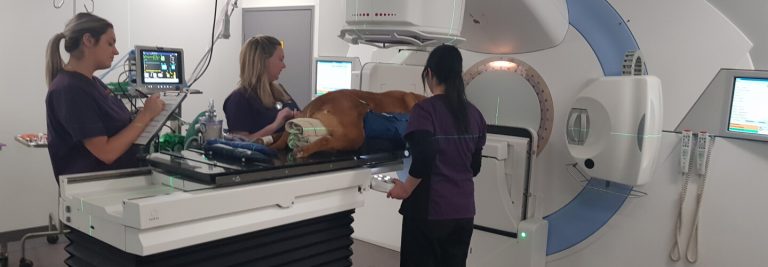By Dr Spela Bavcar (Oncology Specialist)
Osteosarcoma in dogs, also known as bone cancer, is the most common tumour of the bone in dogs. It most often occurs in the long bones of the front limbs (humerus, radius) or hind limbs (femur) and is frequently seen in middle-aged, large, and giant breed dogs. For this reason, it’s full medical name is canine appendicular osteosarcoma.
Osteosarcoma symptoms in dogs
Dogs typically present with signs of lameness and swelling of a limb. It is not uncommon for this lameness to be intermittent and respond to rest and pain relief initially but typically the swelling gets larger, and lameness gets worse as time goes on.
Diagnosing osteosarcoma in dogs
A preliminary diagnosis of osteosarcoma in dogs often based on symptoms and X-ray findings. However, further tests, such as a bone biopsy, are needed to confirm the diagnosis. Sometimes, treatment of this disease is justified before confirmation through a bone biopsy.
Chest X-rays are an important part of the diagnostic workup, as a small percentage of dogs will have evidence of cancer spread to the lungs at the time of initial presentation. Chest and abdominal CT scans are often recommended before surgery, as they are able to detect small amounts of cancer that have spread to other parts of the body. At SASH, the review of these scans will be performed by one of our in-house Diagnostic Imaging Specialists. The daunting task requires an expert as it could involve meticulously reviewing over 3000 images to ensure nothing is missed.
Routine screening of blood and urine are also essential to evaluate the overall health of the patient, and to determine the best therapeutic options. Alkaline phosphatise (ALP) is commonly measured, as it can give a good indication of survival times – a lower value is favourable.
Treating osteosarcoma in dogs
SASH is able to provide a combination of three treatment options for treating osteosarcoma in dogs – surgical, medical, and radiation through the Animal Cancer Centre, a one of a kind, centre of excellence in Australia. Details around treatment options will be discussed with you by SASH Oncology Veterinarians, who are experts in the treatment of cancer. In turn, they will work closely with Surgery Specialists and Radiation Oncologists to provide the most appropriate therapy.
Surgical amputation
Removing the affected limb is commonly the first step in treating osteosarcoma in dogs. Bone tumours are very painful, and excision is the best way to relieve the pain. Amputation has long been the mainstay of therapy for osteosarcoma. Surgery for osteosarcoma, without removing the limb, in certain parts of the body is also an option. However, it carries a high risk of infection and not many dogs are good candidates for this approach.
The median survival times for dogs that undergo amputation alone is measured in months (3-8 months). However, combining surgery with chemotherapy can help improve survival (more below).

The decision to amputate the limb of your pet can be difficult. Thankfully, most dogs adapt well to life on three legs, still with a very good quality of life. SASH Oncologists and other specialist veterinarians will be able to help provide you with all the facts during a consultation, so you are better able to make an informed decision.
Chemotherapy
Medical treatment using chemotherapy drugs (e.g. carboplatin) is often used in conjunction with surgery to treat osteosarcoma in dogs. It is usually given every three-four weeks for six cycles.
Chemotherapy together with surgery can be effective in dogs with osteosarcoma, producing 1-year survival rates of 40-60%.
Radiation therapy
In some cases, dogs may have other conditions (e.g. ortheopaedic or neurologic), where the removal of a limb would result in a severe disability and poor quality of life. Additionally, some owners may elect not to amputate. In these situations, radiation therapy could be an alternative, albeit not as effective as surgery and chemotherapy. Referred to as palliative radiotherapy, it aims to improve quality of life in patients through controlling pain. Palliative radiation consists of 2-5 treatments.
Radiation therapy is effective at controlling pain in up to 70% of osteosarcoma patients for 2-3 months on average.
Osteosarcoma treatment outcomes in dogs
Unfortunately, osteosarcoma in dogs often cannot be completely cured. However, the outcome can be fair if this disease is identified early and no evidence of spread is found prior to surgery. The median survival time for patients treated with surgery and chemotherapy is 12-18 months, 30% survive 2 years after surgery, and 5% survive 5 years after treatment. To put that into perspective, effective treatment can extend the life of patients into their senior years, giving owners more time with their beloved family member, while still maintaining a good quality of life for the patient.
If you have concerns about your pet, ensure you consult with your veterinarian, as an early diagnosis is always better than a late one. If osteosarcoma is suspected, but not confirmed ask for a referral to SASH. The SASH Surgery Specialists are experts in confirming osteosarcoma and will in-turn refer you to a world-class SASH Oncologist.
Call us to book a consult by clicking the contact button below.




